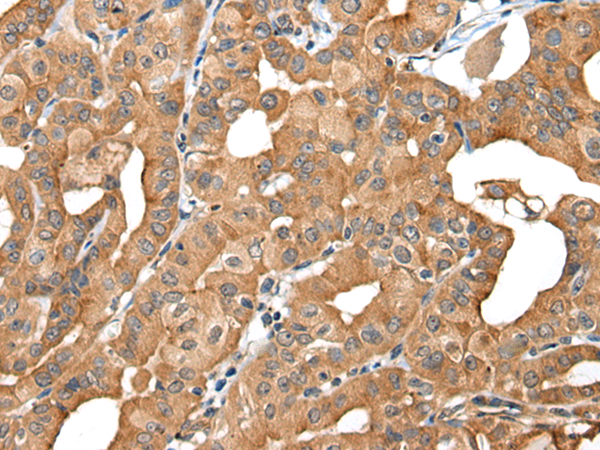
| WB | 咨询技术 | Human,Mouse,Rat |
| IF | 咨询技术 | Human,Mouse,Rat |
| IHC | 1/40-1/200 | Human,Mouse,Rat |
| ICC | 技术咨询 | Human,Mouse,Rat |
| FCM | 咨询技术 | Human,Mouse,Rat |
| Elisa | 1/5000-1/10000 | Human,Mouse,Rat |
| Host/Isotype | Rabbit IgG |
| Antibody Type | Primary antibody |
| Storage | Store at 4°C short term. Aliquot and store at -20°C long term. Avoid freeze/thaw cycles. |
| Species Reactivity | Human, Mouse |
| Immunogen | Fusion protein of human INF2 |
| Formulation | Purified antibody in PBS with 0.05% sodium azide and 50% glycerol. |
+ +
以下是关于INF2抗体的3篇参考文献的简要信息:
---
1. **文献名称**:*INF2 regulates the formation of Golgi-derived microtubules in polarized cells*
**作者**:Andrés-Delgado, L., et al.
**摘要**:该研究通过使用INF2特异性抗体,揭示了INF2在极化细胞中调控高尔基体来源微管形成的作用。实验表明,INF2通过协调微丝与微管的重塑,影响细胞极性和分泌途径,为INF2在细胞骨架动态中的双重功能提供了证据。
---
2. **文献名称**:*INF2 mutations link kidney disease and mitochondrial dysfunction*
**作者**:Brown, E.J., et al.
**摘要**:研究利用INF2抗体分析了突变蛋白在肾小球疾病患者中的表达异常。结果发现,INF2突变导致线粒体分裂缺陷和足细胞损伤,提示其通过影响线粒体-内质网互作参与局灶节段性肾小球硬化(FSGS)的病理机制。
---
3. **文献名称**:*Formin inhibitor SMIFH2 disrupts the INF2-dependent mitochondrial dynamics*
**作者**:Chhabra, E.S., & Higgs, H.N.
**摘要**:本文通过免疫荧光和Western blot结合INF2抗体,探究了药物SMIFH2对INF2介导的线粒体分裂的抑制作用。研究发现,INF2在微丝聚合中的活性对线粒体形态维持至关重要,为靶向INF2的疾病治疗提供了新思路。
---
4. **文献名称**:*INF2-mediated actin polymerization in the regulation of ER-mitochondria contacts*
**作者**:Korobova, F., et al.
**摘要**:该研究使用INF2抗体进行亚细胞定位分析,发现INF2通过促进微丝聚合调控内质网与线粒体接触点的形成,影响脂质转运和钙信号传导,揭示了其在细胞器互作中的关键作用。
---
这些文献涵盖了INF2抗体在细胞骨架调控、疾病机制及药物研究中的应用,突出了其在基础与临床研究中的重要性。
INF2 (Inverted Formin 2) antibodies are tools used to study the role of the INF2 protein, a member of the formin family involved in regulating actin cytoskeleton dynamics. INF2 is unique among formins due to its ability to both promote actin polymerization and depolymerization, playing critical roles in cellular processes like mitochondrial fission, cell migration, and intracellular vesicle trafficking. Mutations in the *INF2* gene are linked to human diseases, notably autosomal dominant focal segmental glomerulosclerosis (FSGS), a kidney disorder, and Charcot-Marie-Tooth disease (CMT), a peripheral neuropathy.
INF2 antibodies are essential for detecting protein expression, localization, and post-translational modifications in research models. They are widely used in techniques such as Western blotting, immunofluorescence, and immunohistochemistry to investigate INF2's interaction with other cytoskeletal regulators (e.g., CDC42. microtubules) and its dysfunction in disease contexts. Studies using these antibodies have revealed INF2's dual role in maintaining podocyte structure in kidneys and regulating mitochondrial morphology in neurons, providing insights into disease mechanisms. Commercial INF2 antibodies are typically raised against specific epitopes, often validated in knockout controls to ensure specificity. Their application continues to advance understanding of cytoskeletal disorders and potential therapeutic targets.
×